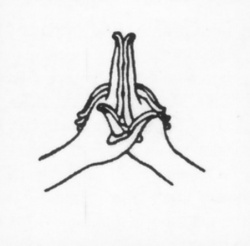Difference between revisions of "Uttarabodhi Mudrā"
Jump to navigation
Jump to search
(Created page with "thumb|250px| <poem> Enlightenment Gesture Sjoquist p. 33 Uttarabodhi Mudrā zuìgāo qǐdí yìn 最高启迪印 最高啟迪印 Th...") |
|||
| Line 1: | Line 1: | ||
[[File:UttarabodhiMudra.JPG|thumb|250px|]] | [[File:UttarabodhiMudra.JPG|thumb|250px|]] | ||
<poem> | <poem> | ||
| − | Enlightenment Gesture | + | |
| − | Sjoquist p. 33 Uttarabodhi Mudrā | + | |
| − | zuìgāo qǐdí yìn 最高启迪印 最高啟迪印 | + | |
| − | This gesture represents highest enlightenment. Both hands are held at the level of the chest, the two raised index fingers touch one another, the remaining fingers are crossed and folded down.; the thumbs touch each other at the tips or are crossed and folded. This mudrā is frequently seen in images of the Buddha Vairocana (Pílú-zhènà fó 毘卢遮那佛 毘盧遮那佛 or 大日如來 Dàrì rúlái). | + | [[Enlightenment Gesture]] |
| + | [[Sjoquist]] p. 33 [[Uttarabodhi Mudrā]] | ||
| + | [[zuìgāo qǐdí yìn]] [[最高启迪印 最高啟迪印]] | ||
| + | |||
| + | This gesture represents [[highest enlightenment]]. Both hands are held at the level of the {{Wiki|chest}}, the two raised index fingers {{Wiki|touch}} one another, the remaining fingers are crossed and folded down.; the thumbs {{Wiki|touch}} each other at the tips or are crossed and folded. | ||
| + | |||
| + | This [[mudrā]] is frequently seen in images of the [[Buddha Vairocana]] ([[Pílú-zhènà fó]] [[毘卢遮那佛 毘盧遮那佛]] or [[大日如來]] [[Dàrì rúlái]]). | ||
</poem> | </poem> | ||
{{R}} | {{R}} | ||
Latest revision as of 23:43, 5 January 2016
Enlightenment Gesture
Sjoquist p. 33 Uttarabodhi Mudrā
zuìgāo qǐdí yìn 最高启迪印 最高啟迪印
This gesture represents highest enlightenment. Both hands are held at the level of the chest, the two raised index fingers touch one another, the remaining fingers are crossed and folded down.; the thumbs touch each other at the tips or are crossed and folded.
This mudrā is frequently seen in images of the Buddha Vairocana (Pílú-zhènà fó 毘卢遮那佛 毘盧遮那佛 or 大日如來 Dàrì rúlái).
